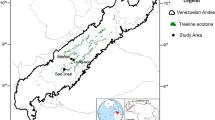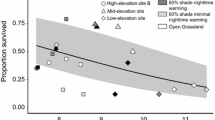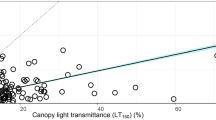Abstract
Many tropical alpine treelines lie below their climatic potential, because of natural or anthropogenic causes. Forest extension above the treeline depends on the ability of trees to establish in the alpine environment. This ability may be limited by different factors, such as low temperatures, excess solar radiation, competition, soil properties, dispersal ability, and fires. In this paper we address the following two questions: Do trees regenerate above the present treeline, and what are the inhibiting factors for tree establishment? To answer these questions we described the spatial pattern of recent tree establishment below and above the present treeline in northern Ecuador. Also, we experimentally transplanted seedlings into the alpine vegetation (páramo) and the forest, and investigated the effect of shade, neighboring plants, and substrate on their survival. The number of naturally occurring tree sprouts (seedlings, saplings and ramets) was highest just outside the forest, and decreased with distance to the forest edge. However, only two species that were radiation-tolerant made up these high numbers, while other species were rare or absent in the páramo. In the forest, the species diversity of sprouts was high and the abundance per species was relatively low. The transplanted seedlings survived least in experimental plots without artificial shade where neighboring plants were removed. Seedling survival was highest in artificially shaded plots and in the forest. This shade-dependence of most tree species can strongly slow down forest expansion toward the potential climatic treeline. Due to the presence of radiation-tolerant species, the complete lack of forest expansion probably needs to be ascribed to fire. However, our results show that natural processes can also explain both the low position and the abruptness of tropical treelines.






Similar content being viewed by others
References
Armand AD (1992) Sharp and gradual mountain timberlines as a result of species interaction. In: Hansen AJ, Castri FD (eds) Landscape boundaries : consequences for biotic diversity and ecological flows. Springer, New York
Bader MY, Rietkerk M, Bregt AK in review. Vegetation structure and temperature regimes of tropical alpine treelines
Ball MC, Hodges VS, Laughlin GP (1991) Cold-induced photoinhibition limits regeneration of snow gum at tree-line. Funct Ecol 5:663–668
Barber J, Andersson B (1992) Too much of a good thing: light can be bad for photosynthesis. Trends Biochem Sci 17:61–66
Beck E, Scheibe R, Schulze ED (1986) Recovery from fire: observations in the alpine vegetation of western Mt. Kilimanjaro (Tanzania). Phytocoenologia 14:55–77
Beyer C (1993) Vergleichende morphologische und anatomische Untersuchungen zur Ontogonie der terrestrischen Loranthaceae. Biologie. Philipps-Universität Marburg, p. 232
Bond WJ, Keeley JE (2005) Fire as a global ’herbivore’: the ecology and evolution of flammable ecosystems. Trends Ecol Evol 20:387–394
Callaway RM (1995) Positive interactions among plants. Bot Rev 61:306–349
Callaway RM, Brooker RW, Choler P, Kikvidze Z, Lortie CJ, Michalet R, Paolini L, Pugnaire FL, Newingham B, Aschehoug ET, Armas C, Kikodze D, Cook BJ (2002) Positive interactions among alpine plants increase with stress. Nature 417:844–848
Camarero JJ, Gutiérrez E (2004) Pace and pattern of recent treeline dynamics: Response of ecotones to climatic variability in the Spanish Pyrenees. Clim Change 63:181–200
Choler P, Michalet R, Callaway RM (2001) Facilitation and competition on gradients in alpine plant communities. Ecology 82:3295–3308
Close DC, Beadle CL, Brown PH, Holz GK (2000) Cold-induced photoinhibition affects establishment of Eucalyptus nitens (deane and maiden) maiden and Eucalyptus globulus labill. Trees—Struct Funct 15(1):32–41
Cuevas JG (2000) Tree recruitment at the Nothofagus pumilio alpine timberline in Tierra del Fuego, Chile. J Ecol 88:840–855
Di Pasquale G, Marziano M, Impagliazzo S, Lubritto C, De Natale A, Bader MY accepted. The Holocene treeline in the northern Andes (Ecuador): first evidence from soil charcoal. Palaeogeogr Palaeoclimatol Palaeoecol
Ellenberg H (1996) Paramos und Punas der Hochanden suedamerikas, heute grossenteils als potentielle Waelder anerkannt. Verhandlungen der Gesellschaft für Oekologie 25:17–24
Germino MJ, Smith WK (1999) Sky exposure, crown architecture, and low-temperature photoinhibition in conifer seedlings at alpine treeline. Plant Cell Environ 22:407–415
Germino MJ, Smith WK, Resor AC (2002) Conifer seedling distribution and survival in an alpine-treeline ecotone. Plant Ecol 162:157–168
Hamilton LS, Juvik JO, Scatena FN (1995) Tropical montane cloud forests. Springer Verlag, New York
Hemp A, Beck E (2001) Erica excelsa as a fire-tolerating component of Mt. Kilimanjaro’s forests. Phytocoenologia 31:449–475
Hofstede R, Segarra P, Mena Vásconez P (eds) (2003) Los páramos del Mundo. Proyecto Atlas Mundial de los Páramos. Global Peatland Initiative/NC-IUCN/EcoCiencia
Hofstede RGM, Chilito EJ, Sandovals EM (1995) Vegetative structure, microclimate, and leaf growth of a paramo tussock grass species, in undisturbed, burned and grazed conditions. Vegetatio 119:53–65
Holtmeier FK (1994) Ecological aspects of climatically-caused timberline fluctuations, review and outlook. In: Beniston M (ed) Mountain environments in changing climates. Routledge, London; New York, pp 220–233
Huner NPA, Öquist G, Sarhan F (1998) Energy balance and acclimation to light and cold. Trends Plant Sci 3:224–230
Kessler M (1995) Present and potential distribution of Polylepis (Rosaceae) forests in Bolivia. In: Churchill SP, Balslev H, Forero E, Luteyn JL (eds) Biodiversity and conservation of Neotropical montane forests, Proceedings of the neotropical montane forest biodiversity and conservation symposium. New York Botanical Garden, pp. 281–294
Kessler M (2000) Observations on a human-induced fire event at a humid timberline in the Bolivian Andes. Ecotropica 6:89–93
Kessler M (2002) The “Polylepis problem”: where do we stand?. Ecotropica 8:97–110
Kitzberger T, Steinaker DF, Veblen TT (2000) Effects of climatic variability on facilitation of tree establishment in northern Patagonia. Ecology 81:1914–1924
Körner C, Paulsen J (2004) A world-wide study of high altitude treeline temperatures. J Biogeogr 31:713–732
Krause GH (1994) Photoinhibition induced by low temperatures. In: Baker NR, Bowyer JR (eds) Photoinhibition of photosynthesis—from molecular mechanisms to the field. BIOS Scientific Publishers, Oxford, pp 331–348
Kuijt J (1963) On the ecology and parasitism of the Costa Rican tree mistletoe, Gaiadendron punctatum (Ruiz & Pavon) G Don. Can J Bot 41:927–936
Kullman L (2001) 20th century climate warming and tree-limit rise in the Southern Scandes of Sweden. Ambio 30:72–80
Kupfer JA, Cairns DM (1996) The suitability of montane ecotones as indicators of global climatic change. Prog Phys Geog 20:253–272
Laegaard S (1992) Influence of fire in the grass páramo vegetation of Ecuador. In: Balslev H, Luteyn JL (eds) Páramo. An Andean ecosystem under human influence. Academic Press, London, pp 151–170
Long SP, Humphries S, Falkowski PG (1994) Photoinhibition of photosynthesis in nature. Annu Rev Plant Physiol Plant Mol Biol 45:633–662
Lundmark T, Hällgren JE (1987) Effects of frost on shaded and exposed spruce and pine seedlings planted in the field. Can J For Res 17:1197–1201
Maher EL, Germino MJ, Hasselquist NJ (2005) Interactive effects of tree and herb cover on survivorship, physiology, and microclimate of conifer seedlings at the alpine tree-line ecotone. Can J For Res 35:567–574
Miehe G, Miehe S (1994) Zur oberen Waldgrenze in tropischen Gebirge. Phytocoenologia 24:53–110
Pugnaire FI, Haase P, Puigdefabregas J (1996) Facilitation between higher plant species in a semiarid environment. Ecology 77:1420–1426
Pugnaire FI, Luque MT (2001) Changes in plant interactions along a gradient of environmental stress. Oikos 93:42–49
Slayter RO, Noble IR (1992) Dynamics of montane treelines. In: Hansen AJ, di Castri F (eds) Landscape boundaries: consequences for biotic diversity and ecological flows. Springer, New York, pp. 346–359
Smith WK, Germino MJ, Hancock TE, Johnson DM (2003) Another perspective on altitudinal limits of alpine timberlines. Tree Physiol 23:1101–1112
Tranquillini W (1979) Physiological ecology of the Alpine timberline : tree existence at high altitudes with special reference to the European Alps. Springer, Berlin
Valladares F, Pearcy RW (1997) Interactions between water stress, sun-shade acclimation, heat tolerance and photoinhibition in the sclerophyll Heteromeles arbutifolia. Plant Cell Environ 20:25–36
van Langevelde F, van de Vijver C, Kumar L, van de Koppel J, de Ridder N, van Andel J, Skidmore AK, Hearne JW, Stroosnijder L, Bond WJ, Prins HHT, Rietkerk M (2003) Effects of fire and herbivory on the stability of savanna ecosystems. Ecology 84:337–350
Vilà M, Lloret F, Ogheri E, Terradas J (2001) Positive fire-grass feedback in Mediterranean Basin woodlands. For Ecol Manage 147:3–14
Wardle P (1985) New Zealand timberlines. 1. Growth and survival of native and introduced tree species in the Craigieburn Range, Canterbury. N Z J Bot 23:219–234
Wardle P, Coleman MC (1992) Evidence for rising upper limits of four native New Zealand forest trees. N Z J Bot 30:303–314
Weltzin JF, McPherson GR (1999) Facilitation of conspecific seedling recruitment and shifts in temperate savanna ecotones. Ecol Monogr 69:513–534
Wesche K, Miehe G, Kaeppeli M (2000) The significance of fire for afroalpine ericaceous vegetation. Mt Res Dev 20:340–347
Wille M, Hooghiemstra H, Hofstede R, Fehse J, Sevink J (2002) Upper forest line reconstruction in a deforested area in northern Ecuador based on pollen and vegetation analysis. J Trop Ecol 18:409–440
Wilson JB, Agnew ADQ (1992) Positive-feedback switches in plant communities. Adv Ecol Res 23:263–336
Acknowledgments
We thank Germán Vargas and the staff and volunteers of Guandera Biological Station for their help and company during the fieldwork, and Robert Hofstede and Ecopar (Quito) for their support and logistic facilitation of our research. We also thank Arnold Bregt, Chris James and two anonymous reviewers for their useful comments on the manuscript. The research of MR is supported by a VIDI grant from the Netherlands Organization for Scientific Research, division Earth and Life Sciences (NWO-ALW).
Author information
Authors and Affiliations
Corresponding author
Rights and permissions
About this article
Cite this article
Bader, M.Y., van Geloof, I. & Rietkerk, M. High solar radiation hinders tree regeneration above the alpine treeline in northern Ecuador. Plant Ecol 191, 33–45 (2007). https://doi.org/10.1007/s11258-006-9212-6
Received:
Accepted:
Published:
Issue Date:
DOI: https://doi.org/10.1007/s11258-006-9212-6




